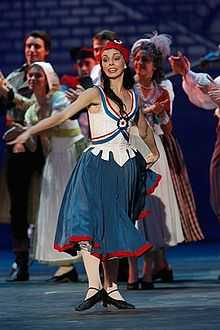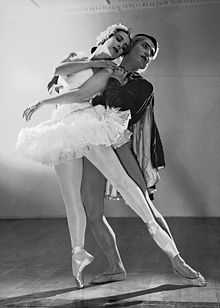Flames of Paris
| Flames of Paris | |
|---|---|
| Choreographer | Vasily Vainonen |
| Music | Boris Asafyev |
| Based on | a book by Felix Gras |
| Premiere |
7 November 1932 Kirov Theatre, Leningrad |
| Characters |
Mireille de Poitiers Jerome Jeanne Theres Mistral |
| Setting | French Revolution |
| Genre | Revolutionary ballet |
| Type | classical ballet |

Flames of Paris (original Russian title Plamya Parizha) is a classical ballet with music by musicologist and composer Boris Asafyev based on songs of the French Revolution, and originally choreographed by Vasily Vainonen, with design by Vladimir Dmitriev. The four-act ballet is based on a book by Felix Gras. Authors of the libretto were Nicolai Volkov and Vladimir Dmitriev.
It was premiered at the Kirov Theatre in Leningrad on 7 November, 1932, with Natalia Dudinskaya as Mireille de Poitiers, Vakhtang Chabukiani as Jerome, Olga Jordan as Jeanne, Nina Anisimova as Therese, and Konstantin Sergeyev as Mistral. The conductor was Yuri Fayer.
Other productions included the one premiered on 6 July 1933 at the Bolshoi Theatre in Moscow, with Aleksey Yermolayev (Jerome), Anastasia Abramova (Jeanne), Nadezhda Kapustina (Therese) and Marina Semenova (Mireille de Poitiers).
The original production and choreography was reconstructed in 2008 by Alexei Ratmansky for the Bolshoi Ballet and is available on DVD with Ivan Vasiliev and Natalia Osipova (Bel Air Classiques).
History
The Flames of Paris is a so-called "revolutionary" ballet, and takes as its subject the French Revolution, including in its scenario the storming of the Tuileries by the Marseillais and their victorious march on Paris. The plot is taken from the book of Felix Gras Les Marceliers.
Although its setting is eighteenth-century France, it is a perfect illustration of Leningrad ballet in the 1920s and 1930s, during which time there was a determined effort to find subjects in world history which reflected the more immediate situation in Russia, and to show that the October Revolution was part of more universal movements and historical events.
Plot Outline
The ballet opens in a forest near Marseilles, where the peasant Gaspard and his children - Jeanne and Pierre - are gathering bushwood.
When a Count and his hunting party arrive, the peasants disperse, but Jeanne attracts the attention of the Count, who attempts to embrace her. When her father intervenes, he is beaten up by the Count's servant and taken away.
Later, in the Marseilles Square, Jeanne tells the people what has happened to her father, and the people's indignation over the injustices of the aristocracy grows. They storm the prison, and free the prisoners of the Marquis de Beauregard.
Next, the court of Versailles in all its decadence is portrayed.
After a performance at the court theatre which is followed by a lush banquet, the officers of the court write a formal petition to the King, requesting permission to deal with the unruly revolutionaries.
The actor Antoine Mistral, discovering this secret document, is killed by the Marquis, but before he dies, he manages to pass the document on to Mireille de Poitiers, who escapes as the sound of the Marseillaise is heard from the windows.
The scene then shifts to a square in Paris, where an uprising and the storming of the palace is prepared.
Mireille rushes in with the document revealing the conspiracy against the revolution, and her bravery is applauded. At the height of this scene, the officers of the Marquis arrive in the square; Jeanne, recognizing the man who insulted her in the woods, runs up and slaps him across the face.
Following this, the crowd rushes upon the aristocrats. To the sound of revolutionary songs, the people storm the palace and burst into the staircase of the front hall. Jeanne attacks the Marquis, who is then killed by her brother, and the Basque Therese sacrifices her life for the Revolution.
Finally, back in the square in Paris, the people celebrate their victory over the defenders of the old regime.
Analysis
In creating the choreography for this rich four-act ballet, Vasily Vainonen drew upon many different sources, as did the composer Boris Asafiev: The Flames of Paris blends classical and character dancing, court music and popular songs, solo performances and huge group scenes.
The choreography is mostly classical but for the part of Therese, for example, Vainonen chose character dancer Nina Anisimova, who danced only character dances, displaying strong, expressive folk movements which symbolize the energy and the spirit of the crowd. On the other hand, the dances for Philippe, one of the Marseillais, and his bride are purely classical: the two characters dance a pas de deux which is done in the true Petipa manner.
In the scene at the palace of Louis XVI, there is a great deal of traditional mime and Marie Antoinette dances a minuet, which is a beautiful piece of choreography in itself.
As a further technique for putting classical dancing on the stage, Vainonen invented the roles of the pair of actors, Mireille de Poitiers and Antoine Mistral, who have been invited by the King to perform at the banquet. These were originally performed by Natalia Dudinskaya and Konstantin Sergeyev and are designed for outstanding ballet dancers who can display their virtuosity in classical pas de deux. These characters are, of course, on the side of the revolutionary mob, so that after the storming of the palace they are joined by the group in dances which include variations, codas, and the participation of an enormous corps de ballet consisting of 24, and later 32, dancers.
Popular culture
The Stars of the Russian Ballet [1] is a 1953 Soviet film production (available on DVD) that contains Swan Lake, The Fountain of Bakhchisarai, and The Flames of Paris.
References
Sources
Bremster, M. (ed.) 1993. "International Dictionary of Ballet" Detroit: St James Press
ISBN 1-55862-084-2 (Vol. 1 and 2)
| ||||||||||||||
| ||||||||||||||||||||||||||||||||||||
